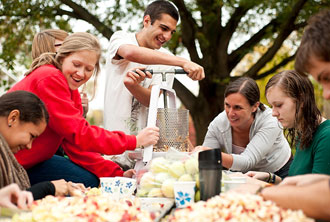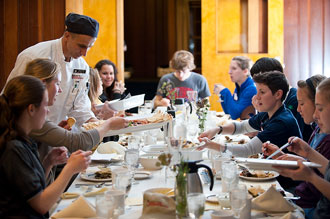New GreenHouse for sustainability nurtures community
Though enticing, the food spread across the tables is only part of the point of this meal. The two dozen students at this Global Food for Thought dinner are here to feed their minds as well as their stomachs.

Undergraduates and staff members from the GreenHouse Residential Learning Community make fresh apple cider in front of Cole Hall on Oct. 25, 2010. GreenHouse is the newest Residential Learning Community on campus, and is focused on advancing sustainability in a broadly encompassing way.
Photo: Bryce Richter
Organized by GreenHouse, a new sustainability-themed Residential Learning Community, the dinner aims to give students an international perspective — in this case, using food as a medium, says community and environmental sociology professor Jack Kloppenburg.
The chef and a guest speaker are on hand to talk about the social and cultural context of the food and issues relevant to a particular part of the world. Tonight’s menu includes spinach pie, Marrakech chicken, and couscous, followed by a discussion of environmental politics and water in the Middle East.
“It’s up to us to help students engage and understand the challenges facing them, and prepare them to be citizens in a world that is going to require that they help things move toward sustainability,” says Kloppenburg, who is faculty director of the new community.
And that means a lot more than just recycling and turning out the lights.
GreenHouse aims to advance sustainability in a broadly encompassing way, says Cal Bergman, who oversees the Residential Learning Communities and other academic programs through University Housing. “For some students it might be about living sustainably with regard to energy conservation, while other students may be thinking more about food and food systems, engineering and building design, or social justice issues,” he says.
GreenHouse opened this fall in Cole Hall, becoming the seventh Residential Learning Community on campus. All seven got a boost this year from the Madison Initiative for Undergraduates, which now provides funds for a dedicated faculty director and part-time academic program coordinator for each community.
The MIU support is enabling University Housing to solicit proposals for two additional RLCs on campus to open in 2012 and 2013. Bergman encourages any faculty or staff on campus to submit a proposal to him by Dec. 15, hoping to expand and diversify the offerings available to students. “We put something in motion with our Learning Communities, and every year something really unexpected and transformative happens because of it,” he says.
At GreenHouse, MIU funds are also being to support three upperclassmen interns. For environmental justice intern Ashley Lee, a senior community and environmental sociology major, GreenHouse’s 46 residents — mostly freshmen -are the payoff for two years of planning with Kloppenburg, Bergman, and others.
“We’re not only educating our students but educating those people they come in contact with throughout their four years,” she says. “They’ll create networks of sustainability across areas of campus where they didn’t already exist.”
In addition to living together, the students have access to a variety of academic and non-academic programming, from one-credit topical seminars on specific environmental issues to cooking meals together in the newly renovated kitchen in their dorm.
“GreenHouse is about breaking students free from a lecture hall where they sit and listen to someone,” Kloppenburg says. “We value experiential education: see it, be it, do it. That’s worth more than all the [PowerPoint] slides I could show.”
And what is more fundamentally experiential than eating?
As the students dig into the meal, Chef Sabi Atteyih describes his Midwestern take on several traditional dishes, including some he created to mimic dishes from his childhood around the Eastern Mediterranean — using local kale instead of grape leaves, for example. He notes that food is a good representation of the sharing and spread of ideas between cultures, with similar dishes distinguished by unique regional ingredients and flavors. “The more I learned, the more I found that people all over have the same foods,” he says, “they just call it something different.”
Now there’s some food for thought.
Tags: housing, learning, student life, sustainability



